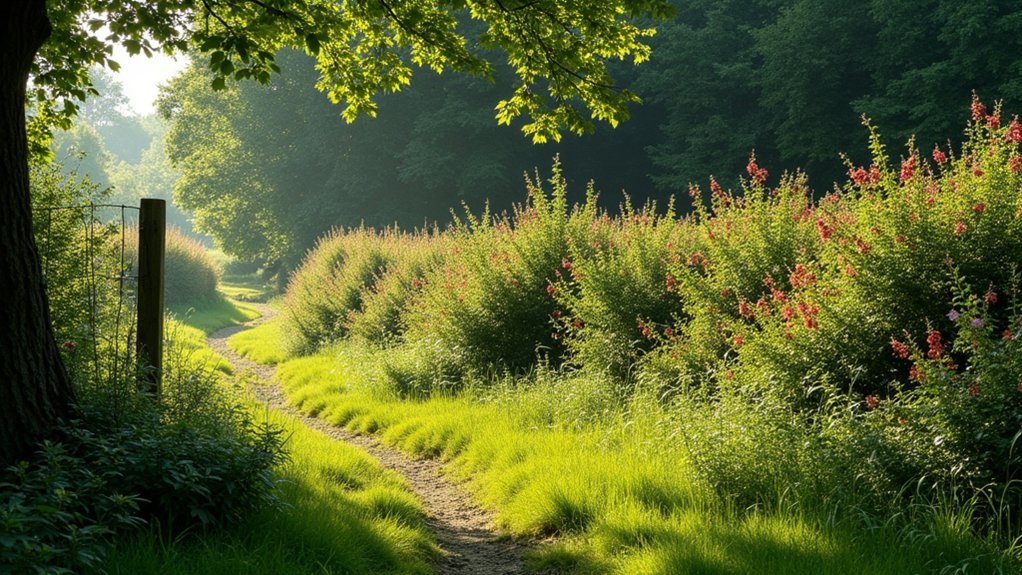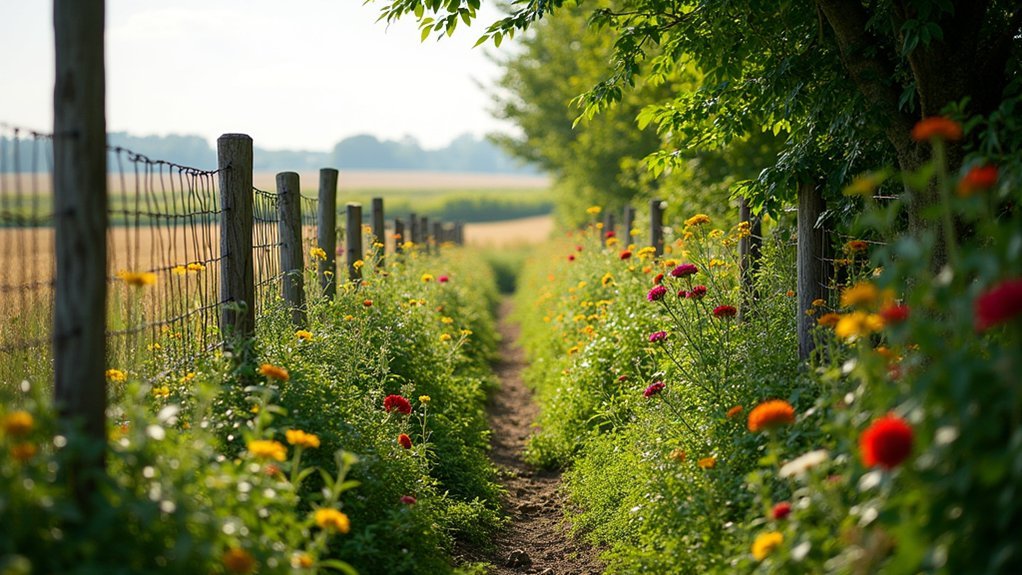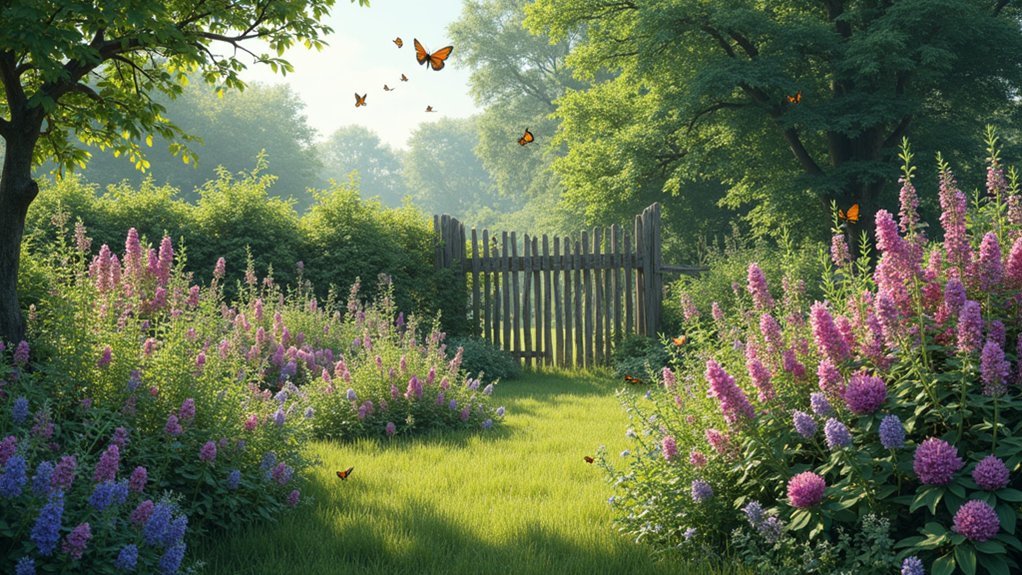Native hedgerows outperform traditional fencing by creating thriving ecosystems while defining boundaries. You’ll enjoy lower long-term maintenance costs as these living barriers mature into dense, beautiful screens that support local wildlife. They combat soil erosion, increase carbon capture, and boost your property value through unique ecological appeal. Unlike conventional fences that deteriorate, native hedgerows grow more valuable over time, transforming your property edges into vibrant habitat corridors that connect with the broader landscape.
The Ecological Advantages of Living Boundaries

While traditional fences merely divide properties, native hedgerows transform boundaries into thriving ecosystems.
These living barriers provide critical habitat for wildlife, supporting mammals, reptiles, and birds that wooden or metal fencing simply can’t accommodate.
When you plant native hedgerows, you’re actively enhancing local biodiversity and contributing to ecosystem resilience.
They create migration corridors for plants and animals while offering year-round shelter and food sources.
Unlike conventional fencing, hedgerows require less maintenance once established because native plants are naturally adapted to local conditions.
Native hedgerows give you the gift of time—thriving with minimal intervention thanks to their perfect adaptation to local environments.
They also work efficiently to suppress weeds through their layered vegetation structure.
For conservation-minded homeowners, hedgerows deliver multiple benefits: they reduce lawn areas, store carbon, and create ecological value where traditional fencing would simply exist as a barrier.
Native Species Selection for Wildlife-Supporting Hedgerows
When planning your wildlife-friendly hedgerow, choose native powerhouses like arrowwood and wild raisin that naturally support local ecosystems while requiring less maintenance than exotic alternatives.
You’ll create season-long habitat benefits by selecting a diverse mix of at least twelve species with staggered flowering times, ensuring resources for pollinators throughout the growing season.
If deer pressure concerns you, consider incorporating naturally resistant native species that form dense, layered vegetation, simultaneously deterring browsing and creating valuable microclimates for birds and small mammals.
Native Plant Powerhouses
Selecting the right native plants transforms an ordinary hedgerow into a thriving wildlife sanctuary. Species like hawthorn, blackthorn, and wild plum work together to provide food and shelter for birds, pollinators, and small mammals throughout the seasons.
You’ll get more than just beauty when you incorporate diverse species such as arrowwood and wild raisin. These native plants are ecological powerhouses, performing essential ecosystem functions including carbon capture and stormwater management.
They’re naturally adapted to local conditions, eliminating the need for chemical interventions that traditional landscaping often requires. Aim for at least a dozen native species in your hedgerow to maximize biodiversity benefits.
Unlike static fencing, these living boundaries enhance visual appeal while creating resilient habitat connections that support wildlife movement across your landscape.
Season-Long Habitat Benefits
Unlike static wooden fences that provide only physical boundaries, thriving native hedgerows offer diverse habitats that evolve with each passing season. When you plant at least a dozen native species in a hedgerow that’s 6-15 feet wide, you’re creating a resilient ecological system that supports biodiversity year-round.
| Season | Wildlife Benefits |
|---|---|
| Spring | Early bloomers attract emerging pollinators |
| Summer | Dense vegetation provides nesting habitats |
| Fall | Berries and seeds offer critical food sources |
| Winter | Evergreen components provide shelter |
| Year-round | Multi-layered structure deters invasive species |
These living boundaries create microhabitats through varied vegetation layers, naturally suppressing invasive plants while providing continuous food sources for wildlife. Unlike fencing that deteriorates over time, native hedgerows actually improve with age, enhancing their season-long value to your local ecosystem.
Deer-Resistant Hedge Options
Although deer can devastate conventional landscapes, strategically chosen native species offer an elegant solution for your wildlife-supporting hedgerows.
Consider incorporating Viburnum dentatum (arrowwood) and Viburnum nudum (wild raisin), which provide dense privacy while remaining unappetizing to deer.
Unlike traditional fencing, these deer-resistant options deliver dual benefits: they create effective boundaries while enhancing ecological benefits in your landscape.
Hazelnut (Corylus americana) adds seasonal interest while deterring browsing, and rosa rugosa offers beautiful blooms without attracting hungry visitors.
For maximum effectiveness, adopt a mixed approach using various native shrubs.
This strategy increases your hedgerow’s resilience against deer damage while promoting biodiversity.
You’ll enjoy a low-maintenance landscaping solution that supports local wildlife habitat without compromise—proving that thoughtfully designed native hedgerows truly outperform conventional barriers in both function and environmental value.
Seasonal Considerations for Pollinator Habitat Fences
When planning your pollinator habitat fence, you’ll need to include plant species that bloom in succession from early spring through late fall to guarantee continuous food sources.
You can enhance winter survival rates by incorporating dense evergreen shrubs and plants with hollow stems where insects can shelter during cold months.
Leaving seedheads and dried flower stalks intact through winter won’t just add visual interest, but will provide essential protective nesting sites for native bees and overwintering butterflies.
Flowering Succession Planning
To establish a thriving pollinator habitat fence, you’ll need to carefully consider flowering succession throughout the growing season. Seasonal flowering patterns guarantee continuous nectar and pollen sources while enhancing your landscape’s visual interest year-round.
- Begin with early bloomers like red chokeberry and flowering quince to support the first pollinators of spring.
- Follow with summer-flowering native species such as wild plum and black-eyed Susan.
- Include late-season plants like goldenrod and asters to provide critical fall resources.
- Mix at least twelve different native plants to promote biodiversity and ecological resilience.
Regular selective pruning maintains healthy growth in your flowering shrubs while preventing weed competition.
This thoughtful approach to your hedgerow creates lasting habitat that supports diverse pollinator populations through changing seasons.
Winter Shelter Design
Creating effective winter shelters within your native hedgerow fence guarantees pollinators have safe havens during the harshest months.
You’ll want to incorporate dense evergreen plants that shield against winter’s bite while maintaining habitat complexity.
Design your hedgerow with a minimum width of 6-15 feet to provide adequate space for diverse wildlife. Include varying plant heights to create beneficial microclimates that support different pollinator species throughout winter.
Native species excel in hedgerows as they’re adapted to local conditions and often provide food sources like berries even during cold periods.
Complete your pollinator habitat by adding groundcovers that flower in late winter, giving early-emerging pollinators immediate sustenance when they need it most.
Unlike traditional fencing, these living barriers offer both protection and nourishment, maintaining biodiversity year-round rather than merely marking boundaries.
Establishing Low-Maintenance Natural Barriers

Although traditional fencing provides immediate boundaries, native hedgerows offer a superior long-term solution for establishing natural barriers that practically maintain themselves.
When you plant a hedgerow, you’re investing in a living boundary that delivers multiple benefits beyond simple privacy and security.
- Native hedgerows thrive naturally, requiring minimal upkeep compared to wooden fences that need regular repairs and treatments.
- Your property gains enhanced biodiversity as these living barriers provide food and shelter for local wildlife.
- Unlike traditional fencing, hedgerows actively combat soil erosion while increasing carbon capture on your land.
- With careful selection of native plants, your hedgerow will mature into a dense, beautiful barrier that outlasts any conventional fence while supporting your local ecosystem.
Hedgerow Design Principles for Maximum Biodiversity
Designing a thriving hedgerow requires thoughtful planning beyond simply planting a row of shrubs. You’ll need at least twelve native plant species to build ecological resilience and support diverse wildlife habitats. Aim for hedgerows at least 6 feet wide—ideally 15 feet—to create a multi-layered structure that shelters birds and mammals.
| Design Element | Biodiversity Benefit | Implementation |
|---|---|---|
| Mixed bloom times | Continuous pollinator food | Include spring, summer, fall flowering shrubs |
| Groundcovers | Support beneficial insects | Add ferns and native wildflowers |
| Connectivity | Facilitates wildlife movement | Link to existing vegetation |
Don’t forget to incorporate groundcovers like ferns and wildflowers to improve ecosystem stability. When you connect your hedgerow to existing vegetation, you’ll create migration corridors that greatly enhance biodiversity levels across your landscape.
Cost Comparison: Traditional Fencing vs. Native Plantings

When you’re deciding between traditional fencing and native hedgerows, the financial implications deserve careful consideration.
While traditional fencing requires a larger upfront investment, native hedgerows offer compelling long-term savings that often get overlooked.
- Initial investment vs. long-term value: Native hedgerows become more cost-effective over time, outlasting traditional fencing that typically needs replacement after a decade.
- Reduced maintenance costs: You’ll spend less on upkeep as established hedgerows require minimal intervention compared to fence repairs.
- Property value enhancement: The ecological benefits of hedgerows supporting wildlife and pollinators can increase your property’s market appeal.
- Financial incentives: Government programs often provide funding for native plantings, offsetting initial costs while traditional fencing rarely qualifies for subsidies.
Enhancing Property Value Through Natural Boundary Solutions
The decision to install native hedgerows rather than traditional fencing can greatly boost your property’s market value while creating a distinctive appeal that stands out to potential buyers.
Unlike harsh man-made structures, these natural boundaries blend seamlessly with your landscape, attracting environmentally conscious buyers willing to pay premium prices.
Your property value increases further as native hedgerows deliver ecological benefits through enhanced biodiversity, making your home part of the sustainable living movement.
They serve dual functions as effective noise barriers and windbreaks, adding practical advantages that traditional fencing can’t match.
You might also qualify for government incentives specifically targeting ecological landscaping, providing additional financial benefits beyond market appreciation.
Today’s real estate market increasingly rewards properties that harmonize with nature while maintaining privacy and boundary definition.
Frequently Asked Questions
Why Are Hedges Better Than Fences?
Hedges are better than fences because you’ll get wildlife habitat, natural beauty, and lower maintenance costs. They’ll also serve as windbreaks, sound barriers, and carbon storage while providing privacy that improves with age.
Can I Replace a Hedge With a Fence?
You can replace a hedge with a fence, but you’ll lose biodiversity benefits. Hedges support wildlife, improve aesthetics, and often need less long-term maintenance than fences, which require eventual replacement or repair.
What Is the Best Hedge to Grow Against a Fence?
For growing against a fence, you’ll find arrowwood and wild raisin viburnum excellent choices. They’re adaptable native shrubs that provide ecological benefits. In smaller spaces, consider dwarf witch-alder or pink meadowsweet for their manageable heights.
Which Is Cheaper, a Hedge or a Fence?
While fences have lower upfront costs, you’ll find hedges cheaper long-term. They outlast standard fencing, require less maintenance once established, and won’t need replacement—making them the more economical boundary solution overall.
In Summary
By choosing native hedgerows over traditional fencing, you’ll create vibrant ecosystems right at your property’s edge. You’re not just defining boundaries—you’re building wildlife corridors that enhance local biodiversity. Your investment in these living barriers will reward you with lower long-term maintenance costs, increased property value, and the satisfaction of knowing you’ve contributed to habitat conservation. Nature’s fences simply work better for everyone involved.





Leave a Reply